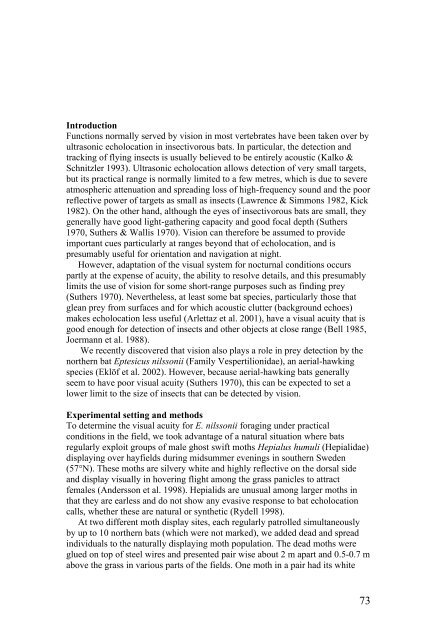Vision in echolocating bats - Fladdermus.net
Vision in echolocating bats - Fladdermus.net
Vision in echolocating bats - Fladdermus.net
Create successful ePaper yourself
Turn your PDF publications into a flip-book with our unique Google optimized e-Paper software.
Introduction<br />
Functions normally served by vision <strong>in</strong> most vertebrates have been taken over by<br />
ultrasonic echolocation <strong>in</strong> <strong>in</strong>sectivorous <strong>bats</strong>. In particular, the detection and<br />
track<strong>in</strong>g of fly<strong>in</strong>g <strong>in</strong>sects is usually believed to be entirely acoustic (Kalko &<br />
Schnitzler 1993). Ultrasonic echolocation allows detection of very small targets,<br />
but its practical range is normally limited to a few metres, which is due to severe<br />
atmospheric attenuation and spread<strong>in</strong>g loss of high-frequency sound and the poor<br />
reflective power of targets as small as <strong>in</strong>sects (Lawrence & Simmons 1982, Kick<br />
1982). On the other hand, although the eyes of <strong>in</strong>sectivorous <strong>bats</strong> are small, they<br />
generally have good light-gather<strong>in</strong>g capacity and good focal depth (Suthers<br />
1970, Suthers & Wallis 1970). <strong>Vision</strong> can therefore be assumed to provide<br />
important cues particularly at ranges beyond that of echolocation, and is<br />
presumably useful for orientation and navigation at night.<br />
However, adaptation of the visual system for nocturnal conditions occurs<br />
partly at the expense of acuity, the ability to resolve details, and this presumably<br />
limits the use of vision for some short-range purposes such as f<strong>in</strong>d<strong>in</strong>g prey<br />
(Suthers 1970). Nevertheless, at least some bat species, particularly those that<br />
glean prey from surfaces and for which acoustic clutter (background echoes)<br />
makes echolocation less useful (Arlettaz et al. 2001), have a visual acuity that is<br />
good enough for detection of <strong>in</strong>sects and other objects at close range (Bell 1985,<br />
Joermann et al. 1988).<br />
We recently discovered that vision also plays a role <strong>in</strong> prey detection by the<br />
northern bat Eptesicus nilssonii (Family Vespertilionidae), an aerial-hawk<strong>in</strong>g<br />
species (Eklöf et al. 2002). However, because aerial-hawk<strong>in</strong>g <strong>bats</strong> generally<br />
seem to have poor visual acuity (Suthers 1970), this can be expected to set a<br />
lower limit to the size of <strong>in</strong>sects that can be detected by vision.<br />
Experimental sett<strong>in</strong>g and methods<br />
To determ<strong>in</strong>e the visual acuity for E. nilssonii forag<strong>in</strong>g under practical<br />
conditions <strong>in</strong> the field, we took advantage of a natural situation where <strong>bats</strong><br />
regularly exploit groups of male ghost swift moths Hepialus humuli (Hepialidae)<br />
display<strong>in</strong>g over hayfields dur<strong>in</strong>g midsummer even<strong>in</strong>gs <strong>in</strong> southern Sweden<br />
(57°N). These moths are silvery white and highly reflective on the dorsal side<br />
and display visually <strong>in</strong> hover<strong>in</strong>g flight among the grass panicles to attract<br />
females (Andersson et al. 1998). Hepialids are unusual among larger moths <strong>in</strong><br />
that they are earless and do not show any evasive response to bat echolocation<br />
calls, whether these are natural or synthetic (Rydell 1998).<br />
At two different moth display sites, each regularly patrolled simultaneously<br />
by up to 10 northern <strong>bats</strong> (which were not marked), we added dead and spread<br />
<strong>in</strong>dividuals to the naturally display<strong>in</strong>g moth population. The dead moths were<br />
glued on top of steel wires and presented pair wise about 2 m apart and 0.5-0.7 m<br />
above the grass <strong>in</strong> various parts of the fields. One moth <strong>in</strong> a pair had its white<br />
73


